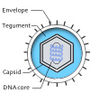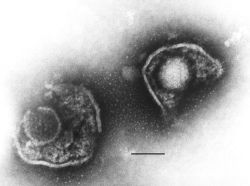Herpesviridae: Difference between revisions
No edit summary |
No edit summary |
||
| Line 1: | Line 1: | ||
{{Viral Biorealm}} | {{Viral Biorealm Family}} | ||
[[Image:025-01.jpg|thumb|250px|right|Human Herpes Virus. Courtesy of [mailto:ackermann@mcb.ulaval.ca Dr. Hans Ackermann]. From the [http://www.ncbi.nlm.nih.gov/ICTVdb/Images/Ackerman/Animalvi/Herpesvi/025-01.htm ICTVdB - Picture Gallery].]] | [[Image:025-01.jpg|thumb|250px|right|Human Herpes Virus. Courtesy of [mailto:ackermann@mcb.ulaval.ca Dr. Hans Ackermann]. From the [http://www.ncbi.nlm.nih.gov/ICTVdb/Images/Ackerman/Animalvi/Herpesvi/025-01.htm ICTVdB - Picture Gallery].]] | ||
Revision as of 15:09, 15 August 2006
A Viral Biorealm page on the family Herpesviridae
Baltimore Classification
Higher order taxa
Virus; dsDNA viruses, no RNA stage; Herpesviridae
Genera
- Alphaherpesvirinae (subfamily)
- Mardivirus
- Simplexvirus
- Varicellovirus
- Iltovirus
- Betaherpesvirinae (subfamily)
- Cytomegalovirus
- Muromegalovirus
- Roseolovirus
- Gammaherpesvirinae (subfamily)
- Lymphocryptovirus
- Rhadinovirus
- (no subfamily)
- Ictalurvirus
Description and Significance
Members of the herpesviridae family include oral and genital herpes, chickenpox, Kaposi's sarcoma herpesvirus (most often seen in people with HIV), and the Epstein-Barr virus (which causes infectious mononucleosis). There are eight known herpesviruses out of 100 known herpesviruses that infect humans.
Herpesviruses are currently being researched for use in medical treatment, especially in the areas of gene therapy and oncology. Research is also being done into interactions between viral and host proteins, the mechanisms involved in gene regulation, and to find out how herpesviruses establish, mantain, and reactivate latency.
The herpesviruses vary greatly in genomic sequence and proteins synthesized, but they all share similar genome and virion structures. (sources: Weir, Roizman)
Genome Structure
Herpesviruses have a non-segmented genome which is 120-230kbp long and contains 60 to 120 genes. The genome contains one molecule of double-stranded DNA. Base content is 31% to 75% guanine + cytosine. Genes are encoded as either essential or dispensable; the essential genes regulate transcription and are needed for virion, while the dispensable genes (which are required in order for an infection to occur) promote cell-to-cell spread, defend the virus from the host's immune system, and make the cellular environment ideal for virus production. There are direct and inverted terminal repeats on all herpesvirus genomes. (sources: ICTVdB, Roizman)
Virion Structure of a Herpesvirus

All herpesvirus virions consist of four elements: an envelope, a tegument, a capsid, and a core. The DNA, wound in a toroidal shape, makes up the core. The isometric capsid consists of 162 capsomers and has a diameter of 100-110nm. The tegument is an amorphous, occasionaly asymmetrical, feature which consists of viral enzymes. The outermost element is the envelope, which contains the tegument, capsid, and core. The surface projections are spikes which evenly cover the surface of the virion. The diameter of the entire virion is 120-200nm. (sources: ICTVdB, Roizman, Weir)
Reproductive Cycle of a Herpesvirus in a Host Cell
A herpesvirus infection begins with attachment to and penetration of a host cell (usually a post-mitotic cell). Since herpesviruses are large DNA viruses, and they usually infect non-dividing cells, they encode enzymes involved in nucleic acid metabolism and DNA synthesis so they can copy their DNA once they enter the host cell. Herpesviruses replicate in the nucleus of the host cell. Immediate-early genes are expressed in the presence of inhibitors of protein synthesis. The immediate-early genes are for the most part regulatory, switching on the expression of the early genes, which are made before DNA replication. The proteins made by the expression of the early genes include enzymes involved in DNA metabolism and replication. The late genes are expressed after DNA replication, and are encoded to make structural proteins as well as elements of the tegument. (source: Dewhurst)
Viral Ecology & Pathology
Herpesviruses infect a wide range of vertebrates, and even some invertebrates such as oysters. In humans, herpesviruses can infect people of all ages and lifestyles. For several of the human herpesviruses, sexual contact is the most common form of transmission. One strain of human herpesvirus, HHV-8 (also known as Kapsi's sarcoma) is prevalent in immuno-suppressed individuals, such as people who have had an organ transplant and are taking immuno-suppressing drugs, and those with HIV. (source: Roizman)
References. Updated June 6, 2006
Dewhurst, Steve. Herpesviruses: Basics (2003).
ICTVdB - The Universal Virus Database, version 4. http://www.ncbi.nlm.nih.gov/ICTVdb/ICTVdB/
Weir, Jerry P. " Genomic Organization and Evolution of the Human Herpesviruses." Virus Genes 16.1 (1998): 85-93.

